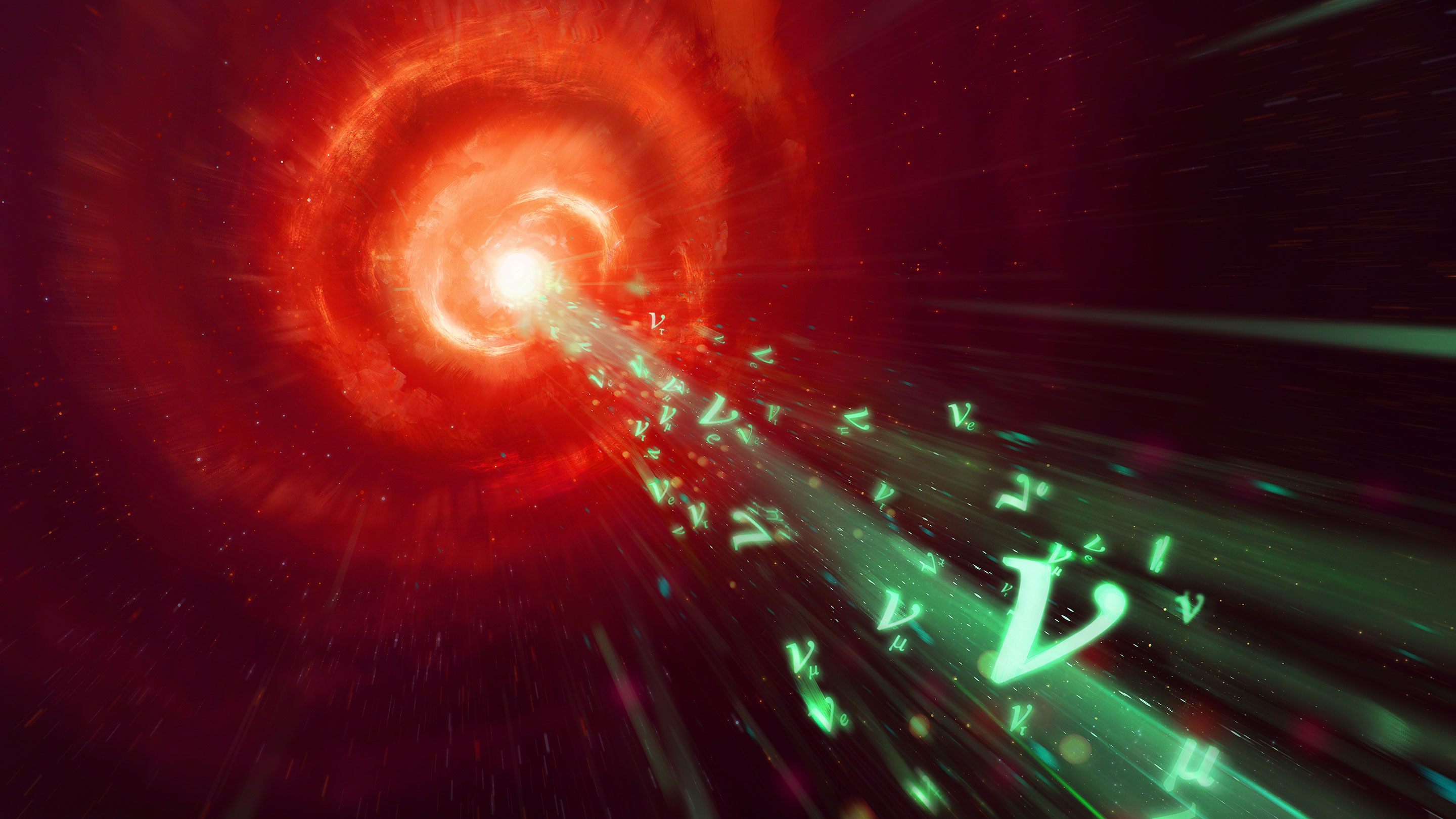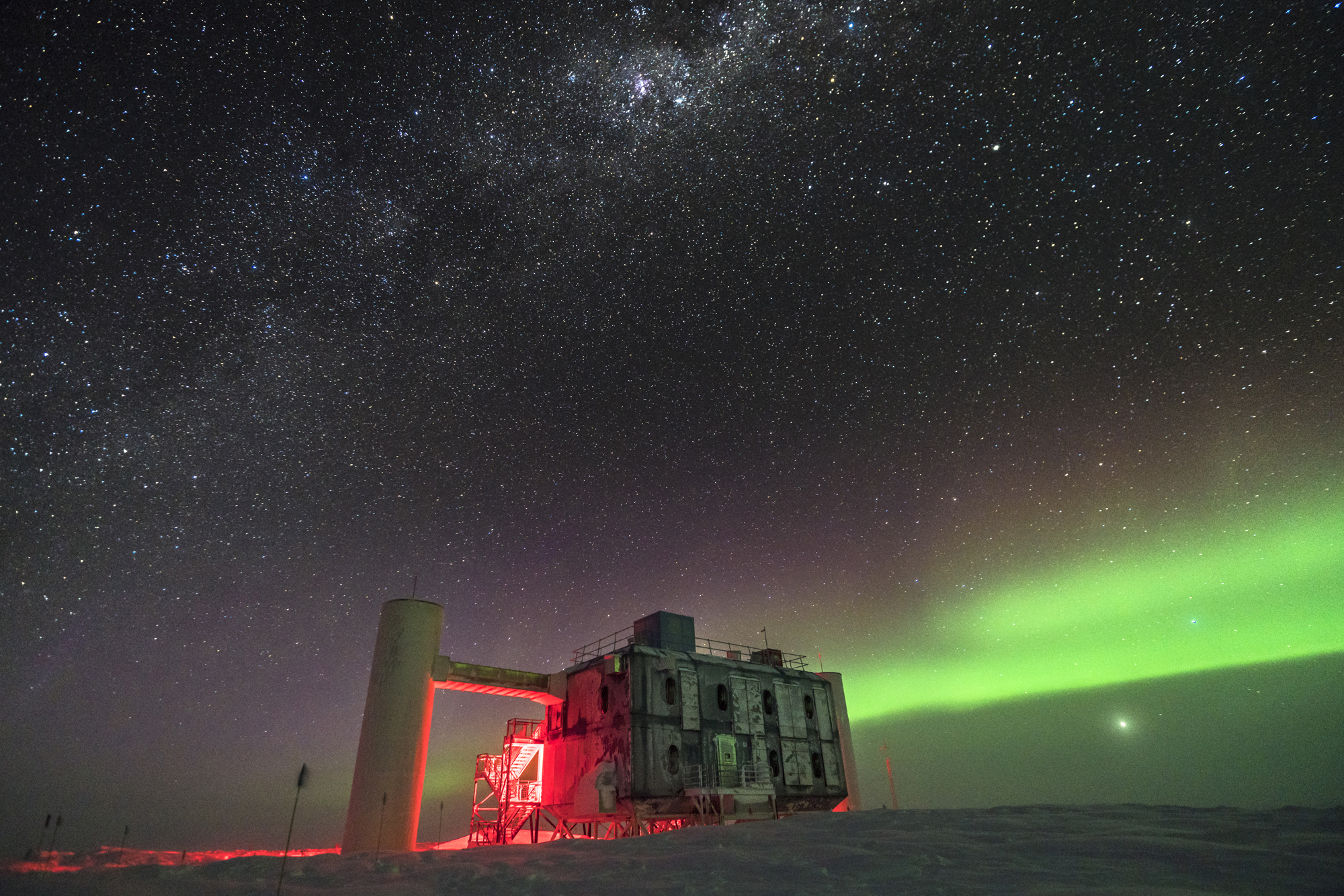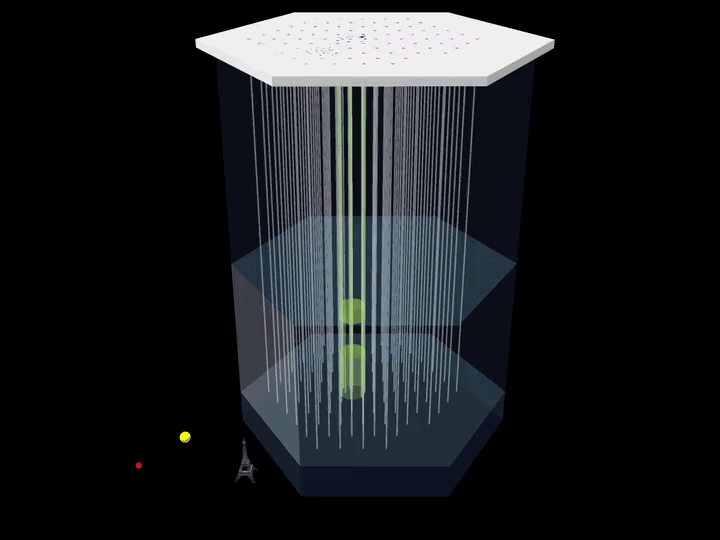Neutrinos Linked With Cosmic Source for the First Time

Maciej Rebisz for Quanta Magazine
Introduction
Last September, a rare guest from far beyond the Milky Way ushered in a new era of astronomy. The visitor, an ultrahigh-energy cosmic neutrino, bumped into ice more than a mile beneath the South Pole, where detectors from the IceCube experiment were waiting to catch it. After quickly tracking the direction from where it came, physicists got lucky: Another telescope, this one orbiting Earth, spotted a stream of extremely energetic radiation coming from the same direction.
The twin events could have been a cosmic coincidence. But when physicists looked through their archived data, they found several other neutrinos that appear to have come from the same direction. This supporting evidence has convinced them that they’ve achieved a cosmic first: tracing ultrahigh-energy neutrinos back to their astrophysical source.
That source appears to be a supermassive black hole at the center of a distant galaxy. Every time a black hole gobbles up a star, it spews out a stream of very high-energy radiation in the form of a laserlike jet. Astronomers say that it “flares.” They call these flaring black holes blazars and believe that energetic neutrinos are created as a by-product of the radiation.
The find, described in a series of two papers published in Science, has not only settled a long-standing debate in astronomy over the origin of high-energy neutrinos. This discovery is also the second example (after last year’s observation of colliding neutron stars) of a new scientific approach called multimessenger astronomy, in which astronomers use both light and another cosmic messenger (neutrinos in this case, gravitational waves in the other) to reveal the details of an astrophysical event. “This is like getting an entirely new way of looking at the universe,” said Roopesh Ojha, an astrophysicist at NASA Goddard Space Flight Center.
Global Alert
When the neutrino arrived, Albrecht Karle, a leader of the IceCube experiment, was in his office at the University of Wisconsin, Madison, preparing for his November trip to the South Pole. IceCube detects more than 50,000 neutrino candidates every year, but only about 10 of them are at the very high energies that indicate that they come from outside the Milky Way galaxy. When the detector spots a candidate high-energy neutrino, within minutes it sends an alert to members of the team and to observatories around the world.
The alert that popped up on Karle’s computer said that the candidate neutrino, dubbed IceCube-170922A, carried around 300 teraelectron-volts of energy, more than 40 times the energy of the protons produced by the Large Hadron Collider near Geneva. “I am normally not easy to get excited, but this one smells right,” Karle said to Elisa Bernardini, an astroparticle physicist at Humboldt University of Berlin.

The IceCube laboratory at the South Pole houses the computers that collect data from thousands of detectors buried in ice.
Enter Fermi. When IceCube spotted the neutrino, the space-based Fermi Large Area Telescope happened to be scanning the area of the sky from which it appeared. It also recorded an unusually intense flare of gamma radiation. Ojha works with the Fermi telescope, and when IceCube’s alert landed in his inbox, he “straightaway knew that that was something interesting.” Sure enough, he found a match. There, a bit to the west of Bellatrix, a star in the constellation Orion, lives a blazar dubbed TXS 0506+056.
Next, Ojha checked a catalog of radio sources, while a colleague examined optical sources. They found a surge in gamma rays, radio waves and optical waves coming from the blazar. It was flaring.
All blazars are “inherently variable objects,” said Ojha, but over the previous three months, this one had moved from being the 51st brightest in one particular catalog into the top five. Along with Fermi, the flare was also seen by Swift, another space-based gamma-ray telescope.
On the Canary Islands, at the ground-based gamma-ray telescope Magic, the excitement was growing as well. After a few nights of bad weather, the flare came into focus — and the telescope registered gamma rays with energies exceeding 400 gigaelectron-volts. The surge in radiation was confirmed by several instruments, in “an exciting, frenetic series of email exchanges,” said Sara Buson, an astrophysicist at NASA Goddard Space Flight Center.
Just as in the case of the neutron star merger, astronomers all over the world leaped into action. In the days and weeks that followed IceCube’s original alert, more and more instruments swiveled toward the blazar. Eventually a total of 18 observatories would record radiation in various wavelengths in exactly the spot where the neutrino was thought to have come from.
What Neutrinos Reveal
Neutrinos, though infamously difficult to detect, offer a key advantage over observations with light: The universe is essentially opaque to electromagnetic radiation above a certain energy. High-energy neutrinos, on the other hand, zip across the cosmos unimpeded. When they are caught, the original information they carry remains intact, no matter how far they have had to travel. Scientists hope that with enough neutrinos, they’ll be able image their sources — including the most energetic events in the universe — just like we do with electromagnetic radiation.

When a neutrino travels through ice, it gives off a faint glow that can be picked up by IceCube’s photodetectors and tracked back to the area of the sky where the neutrino originated.
Scientists believe that this discovery is a crucial step toward solving a number of physics puzzles, such as the origin of ultrahigh-energy cosmic rays. These particles, made of protons or heavier atomic nuclei, rain down on Earth from space and are believed to be born in the same processes as neutrinos. Researchers posit that they might come from a merger of two neutron stars or that perhaps they’re generated by magnetars — rapidly rotating neutron stars that produce strong magnetic fields. The finding could also help to determine the precise mass of the neutrino, spot other predicted types of neutrinos such as sterile neutrinos, and even possibly detect dark matter.
To do this, astronomers will have to find more neutrinos, at higher energies, and quickly link them back to their sources in the sky. Even this neutrino, energetic as it was, can’t compare to the most energetic neutrinos that IceCube has spotted, among them a trio of neutrinos with energies in the petaelectron-volt range, or 1,000 times that of a teraelectron-volt.
These neutrinos, with the Sesame Street–inspired names Ernie, Bert and Big Bird, haven’t yet been definitively traced back to their sources (although there is a suggestion that Big Bird might have originated in the flaring blazar PKS B1424-418). The makeup of these neutrinos is partly to blame for the uncertainty, because they all come from the electron neutrino family. Such neutrinos produce cascades of particles in the IceCube detector, which radiate out like a wide ice-cream cone. This makes it relatively easy to estimate the neutrino’s energy, but hard to track its direction. Muon neutrinos, on the other hand, produce a long, straight cascade of particles, which gives them a precise direction and an uncertain energy. (The neutrino observed last September was a muon neutrino.)
Over the past few years, said Karle, IceCube has detected neutrinos with probably even higher energy levels than the Sesame Street trio, although some of the data is still being analyzed. IceCube scientists have already analyzed four more years of data beyond the original data set from 2010 and 2011, when Ernie and Bert were detected. So far, they have found a total of 54 additional high-energy neutrino events. “This is a great time to be alive,” said Ojha.



